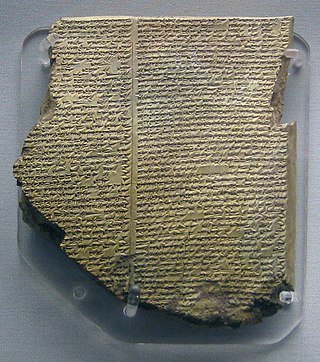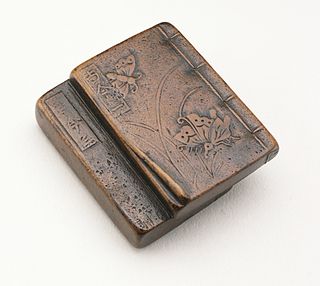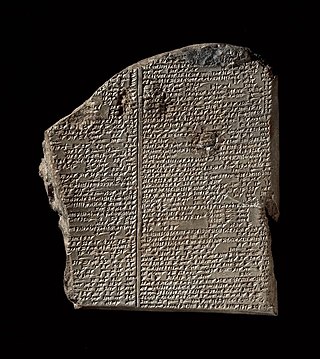Related Research Articles

An epic poem, or simply an epic, is a lengthy narrative poem typically about the extraordinary deeds of extraordinary characters who, in dealings with gods or other superhuman forces, gave shape to the mortal universe for their descendants.

Poetry is a form of literary art that uses aesthetic and often rhythmic qualities of language to evoke meanings in addition to, or in place of, literal or surface-level meanings. Any particular instance of poetry is called a poem and is written by a poet. Poets use a variety of techniques called poetic devices, such as assonance, alliteration, euphony and cacophony, onomatopoeia, rhythm, and sound symbolism, to produce musical or incantatory effects. Most poems are formatted in verse: a series or stack of lines on a page, which follow a rhythmic or other deliberate pattern. For this reason, verse has also become a synonym for poetry.

In prosody, alliterative verse is a form of verse that uses alliteration as the principal device to indicate the underlying metrical structure, as opposed to other devices such as rhyme. The most commonly studied traditions of alliterative verse are those found in the oldest literature of the Germanic languages, where scholars use the term 'alliterative poetry' rather broadly to indicate a tradition which not only shares alliteration as its primary ornament but also certain metrical characteristics. The Old English epic Beowulf, as well as most other Old English poetry, the Old High German Muspilli, the Old Saxon Heliand, the Old Norse Poetic Edda, and many Middle English poems such as Piers Plowman, Sir Gawain and the Green Knight, Layamon's Brut and the Alliterative Morte Arthur all use alliterative verse.

Chinese poetry is poetry written, spoken, or chanted in the Chinese language, and a part of the Chinese literature. While this last term comprises Classical Chinese, Standard Chinese, Mandarin Chinese, Yue Chinese, and other historical and vernacular forms of the language, its poetry generally falls into one of two primary types, Classical Chinese poetry and Modern Chinese poetry.

Japanese poetry is poetry typical of Japan, or written, spoken, or chanted in the Japanese language, which includes Old Japanese, Early Middle Japanese, Late Middle Japanese, and Modern Japanese, as well as poetry in Japan which was written in the Chinese language or ryūka from the Okinawa Islands: it is possible to make a more accurate distinction between Japanese poetry written in Japan or by Japanese people in other languages versus that written in the Japanese language by speaking of Japanese-language poetry. Much of the literary record of Japanese poetry begins when Japanese poets encountered Chinese poetry during the Tang dynasty. Under the influence of the Chinese poets of this era Japanese began to compose poetry in Chinese kanshi); and, as part of this tradition, poetry in Japan tended to be intimately associated with pictorial painting, partly because of the influence of Chinese arts, and the tradition of the use of ink and brush for both writing and drawing. It took several hundred years to digest the foreign impact and make it an integral part of Japanese culture and to merge this kanshi poetry into a Japanese language literary tradition, and then later to develop the diversity of unique poetic forms of native poetry, such as waka, haikai, and other more Japanese poetic specialties. For example, in the Tale of Genji both kanshi and waka are frequently mentioned. The history of Japanese poetry goes from an early semi-historical/mythological phase, through the early Old Japanese literature inclusions, just before the Nara period, the Nara period itself, the Heian period, the Kamakura period, and so on, up through the poetically important Edo period and modern times; however, the history of poetry often is different from socio-political history.
Old Norse poetry encompasses a range of verse forms written in the Old Norse language, during the period from the 8th century to as late as the far end of the 13th century. Old Norse poetry is associated with the area now referred to as Scandinavia. Much Old Norse poetry was originally preserved in oral culture, but the Old Norse language ceased to be spoken and later writing tended to be confined to history rather than for new poetic creation, which is normal for an extinct language. Modern knowledge of Old Norse poetry is preserved by what was written down. Most of the Old Norse poetry that survives was composed or committed to writing in Iceland, after refined techniques for writing were introduced—seemingly contemporaneously with the introduction of Christianity: thus, the general topic area of Old Norse poetry may be referred to as Old Icelandic poetry in literature.
Alice Fulton is an American author of poetry, fiction, and nonfiction. Fulton is the Ann S. Bowers Professor of English Emerita at Cornell University. Her awards include the American Academy of Arts and Letters Award in Literature, National Endowment for the Arts Fellowship, Library of Congress Rebekah Johnson Bobbitt National Award, the MacArthur Fellowship, an Ingram Merrill Foundation Award, as well as a Guggenheim Fellowship.
New Formalism is a late 20th- and early 21st-century movement in American poetry that has promoted a return to metrical, rhymed verse and narrative poetry on the grounds that all three are necessary if American poetry is to compete with novels and regain its former popularity among the American people.

Culture of Somaliland encompasses a wide range of Somali activity and Islamic structures that give Somaliland a rich cultural and historical heritage. Nomadic and Arab Islamic cultural significance have also played a key role in Somaliland's cultural history.
Icelandic literature refers to literature written in Iceland or by Icelandic people. It is best known for the sagas written in medieval times, starting in the 13th century. As Icelandic and Old Norse are almost the same, and because Icelandic works constitute most of Old Norse literature, Old Norse literature is often wrongly considered a subset of Icelandic literature. However, works by Norwegians are present in the standard reader Sýnisbók íslenzkra bókmennta til miðrar átjándu aldar, compiled by Sigurður Nordal on the grounds that the language was the same.

Poetry as an oral art form likely predates written text. The earliest poetry is believed to have been recited or sung, employed as a way of remembering oral history, genealogy, and law. Poetry is often closely related to musical traditions, and the earliest poetry exists in the form of hymns, and other types of song such as chants. As such, poetry is often a verbal art. Many of the poems surviving from the ancient world are recorded prayers, or stories about religious subject matter, but they also include historical accounts, instructions for everyday activities, love songs, and fiction.

Somali literature is the literature used by the ethnic Somalis of Somalia, Somaliland, Djibouti, Yemen, Eritrea, Ogadenia, and Kenya.
The long poem is a literary genre including all poetry of considerable length. Though the definition of a long poem is vague and broad, the genre includes some of the most important poetry ever written.
Political poetry brings together politics and poetry. According to "The Politics of Poetry" by David Orr, poetry and politics connect through expression and feeling, although both of them are matters of persuasion. Political poetry connects to people's feelings, and politics connects to current events. Poetry can also make political references and have real effects on the perception of politics.
Women in Somalia form a key part of Somali society, with clearly defined and important roles in the family and structure. This includes Somali women in Somaliland, a self-declared republic that is internationally recognized as an autonomous region of Somalia. From the time of Ismail Urwayni's proselytizing in 1890, until the Dervish State's defeat by British air bombardment in 1920, women in the strip of land from Jidali, Sanaag in the north, to Beledweyne in the south were referred to as Darawiishaad (plural) or Darwiishad (singular).

The literature of Djibouti has a longstanding poetic tradition. Several well-developed Somali forms of verse include the gabay, jiifto, geeraar, wiglo, buraanbur, beercade, afarey and guuraw. The gabay has the most complex length and meter, often exceeding 100 lines. It is considered the mark of poetic attainment when a young poet is able to compose such verse, and is considered the height of poetry. Groups of memorizers and reciters (hafidayaal) traditionally propagated the well-developed art form. Poems revolve around several main themes, including baroorodiiq (elegy), amaan (praise), jacayl (romance), guhaadin (diatribe), digasho (gloating) and guubaabo (guidance). The baroorodiiq is composed to commemorate the death of a prominent poet or figure. The Afar are familiar with the ginnili, a kind of warrior-poet and diviner, and have a rich oral tradition of folk stories. They also have an extensive repertoire of battle songs.
Yemenite Jewish poetry, often referred to as "paraliturgical poetry" because of its religious nature, has been an integral part of Yemenite Jewish culture since time immemorial. The Jews of Yemen have preserved a well-defined singing arrangement which not only includes the very poetic creation itself, but also involves a vocal and dance performance, accompanied in certain villages outside Sana'a by drumming on an empty tin-can (tanakeh) or a copper tray. The Jews of Yemen, maintaining strict adherence to Talmudic and Maimonidean halakha, observed the gezeirah which prohibited playing musical instruments, and "instead of developing the playing of musical instruments, they perfected singing and rhythm." This arrangement was integrated into the walks of life familiar to the Jews of Yemen. The texts used in the arrangement were put down in writing and later included in separate song collections (dīwāns). The social strictures and norms in Yemenite Jewish culture provide for separate settings for men and for women, where the sexes are never mixed. Men’s song usually expressed the national aspirations of the Jewish people, and it was far removed from the singing associated with the Muslim environment, whereas folk songs of Jewish women were sung by rote memory and expressed the happiness and sorrows inherent in their daily life and was, as a rule, closer to that of Muslim women.
Hawa Jibril (1920–2011) was a Somali poet, known especially for her work in the buraanbur genre.
Feminist poetry is inspired by, promotes, or elaborates on feminist principles and ideas. It might be written with the conscious aim of expressing feminist principles, although sometimes it is identified as feminist by critics in a later era. Some writers are thought to express feminist ideas even if the writer was not an active member of the political movement during their era. Many feminist movements, however, have embraced poetry as a vehicle for communicating with public audiences through anthologies, poetry collections, and public readings.
Sesotho poetry is a form of artistic expression using the written and spoken word practiced by the Basotho people in Southern Africa. Written poetry in the Sesotho language has existed for over 150 years however, the oral poetry has been practiced throughout Basotho history.
References
- ↑ Mohamed Diriye Abdullahi, Culture and Customs of Somalia, (Greenwood Press: 2001), p.75-76
- 1 2 Wieringa, Saskia, ed. (1995). Subversive women: historical experiences of gender and resistance (Second impression [without index]. ed.). London, Angleterre: Zed. p. 174. ISBN 1856493180.
- ↑ De Haan, Arjan; Oonk, Gijsbert (1996). "Book Reviews : The Origins of Industrial Capitalism in India. Business Strategies and the Working Classes in Bombay, 1900-1940 by Rajnarayan Chandavarkar. Cambridge University Press, 1994. Pp. 468". South Asia Bulletin . 16 (2): 82. doi:10.1177/026272809601600108. S2CID 144131560.
- ↑ "Ufahamu". 10. 1981: 116.
{{cite journal}}: Cite journal requires|journal=(help) - ↑ Jama 1994, op. cit., p. 179.